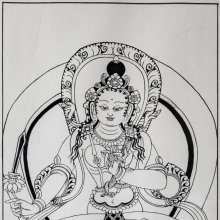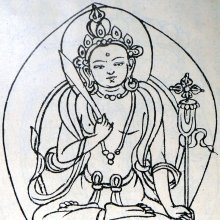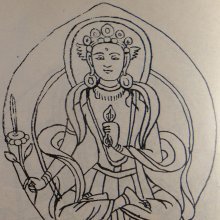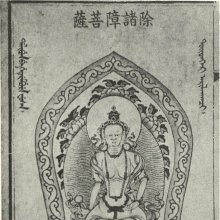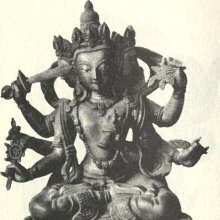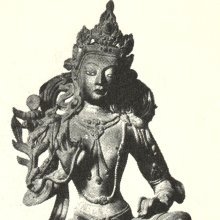Sarvanivaranavishkambhin, Sarvanivaraṇaviṣkambhin, Sarvanivaraṇaviṣkambhī, Sarvanīvaraṇaviṣkambhī, Sarvanīvaraṇaviṣkambhin, Sarvanivaranavishkambhi: 12 definitions
Introduction:
Sarvanivaranavishkambhin means something in Buddhism, Pali, Hinduism, Sanskrit. If you want to know the exact meaning, history, etymology or English translation of this term then check out the descriptions on this page. Add your comment or reference to a book if you want to contribute to this summary article.
The Sanskrit terms Sarvanivaraṇaviṣkambhin and Sarvanivaraṇaviṣkambhī and Sarvanīvaraṇaviṣkambhī and Sarvanīvaraṇaviṣkambhin can be transliterated into English as Sarvanivaranaviskambhin or Sarvanivaranavishkambhin or Sarvanivaranaviskambhi or Sarvanivaranavishkambhi, using the IAST transliteration scheme (?).
Images (photo gallery)
(+3 more images available)
In Buddhism
Tibetan Buddhism (Vajrayana or tantric Buddhism)
Source: Wisdom Library: MañjuśrīnāmasaṃgītiSarvanivaraṇaviṣkambhin (सर्वनिवरणविष्कम्भिन्) is one of the sixteen bodhisattvas appearing in the Vajradhātu-mahāmaṇḍala, according to the Nāmamantrārthāvalokinī v5.38-41. The Nāmamantrārthāvalokinī (literally, ‘an explanation of the nāma-mantras’) is a commentary (ṭīkā) on the 8th century Mañjuśrīnāmasaṃgīti.
Sarvanivaraṇaviṣkambhin is a name of Mañjuśrī (the embodiement of non-dual knowledge) and, together with other names, forms the core essence of the Mañjuśrīnāmasaṃgīti. The Nāmamantrārthāvalokinī provides the practitioner a sādhana (‘meditative practice’) to turn these names into mantras. These mantras are chanted for the benefit of all beings, and then placed and contemplated in the Vajradhātu-mahāmaṇḍala, which is an extended version of the Vajradhātu-maṇḍala.
Source: Wisdom Library: Tibetan BuddhismSarvanīvaraṇaviṣkambhin (सर्वनीवरणविष्कम्भिन्) is the name of a Bodhisattva mentioned as attending the teachings in the 6th century Mañjuśrīmūlakalpa: one of the largest Kriyā Tantras devoted to Mañjuśrī (the Bodhisattva of wisdom) representing an encyclopedia of knowledge primarily concerned with ritualistic elements in Buddhism. The teachings in this text originate from Mañjuśrī and were taught to and by Buddha Śākyamuni in the presence of a large audience (including Sarvanīvaraṇaviṣkambhin).
Source: archive.org: The Indian Buddhist Iconography1) Sarvanivaraṇaviṣkambhin (सर्वनिवरणविष्कम्भिन्) (“effacer of all sins”) is the name of a Bodhisattva commonly depicted in Buddhist Iconography, and mentioned in the 11th-century Niṣpannayogāvalī of Mahāpaṇḍita Abhayākara.—his color is white or blue; his symbol is the sword and book.—Sarvanivaraṇaviṣkambhin is also known by his shorter name of Viṣkambhin, and his statuettes occur at least four times in the Chinese collection. He is popular also in Tibet.
Sarvanivaraṇaviṣkambhin is described in the Niṣpannayogāvalī as follows:—
(1: Mañjuvajra-maṇḍala):—“Sarvanivaraṇaviṣkambhī is of either blue or white colour. With the left hand he displays the Bhūṣparśa (earth-touching) mudrā; with the thumb and the index finger joined together in the clenched right hand he displays the act of pacification”. (2: Dharmadhatūvāgīśvara-maṇḍala):—“Sarvanivaraṇaviṣkambhī is blue in colour. With his right hand he holds the sword and with the left the banner marked with a double thunderbolt”.
2) Sarvanivaraṇaviṣkambhī (सर्वनिवरणविष्कम्भी) or Sarvanivaraṇaviṣkambhīlokeśvara refers to number 38 of the 108 forms of Avalokiteśvara found in the Machhandar Vahal (Kathmanu, Nepal). [Machhandar or Machandar is another name for for Matsyendra.].
Accordingly,—
“Sarvanivaraṇaviṣkambhī is one-faced and two-armed and sits in the Vajraparyaṅka attitude on a lotus. His right hand holds by its stem a lotus on which there is a sword, and his left hand holds the Vajra against his chest”.
The names of the 108 deities [viz., Sarvanivaraṇaviṣkambhī] possbily originate from a Tantra included in the Kagyur which is named “the 108 names of Avalokiteshvara”, however it is not yet certain that this is the source for the Nepali descriptions.Source: Wisdomlib Libary: Vajrayogini
Sarvanīvaraṇaviṣkambhin (सर्वनीवरणविष्कम्भिन्) is the name of a deity to be contemplated upon by a practicioner purifying his correspondences (viśuddhi), according to the 12th-century Abhisamayamañjarī. Sarvanīvaraṇaviṣkambhin is alternatively known by the name Mātsaryavajra because he destroyes miserliness (mātsarya). The contemplation is prescribed as a preliminary ritual for a yogin wishing to establish, or reestablish the union with a deity.
Sarvanīvaraṇaviṣkambhin is associated with the whole body and the color dark(-green). He is to be visualised as holding an attribute in his right hand and a bell in his left. The deities of the sense organs and fields are the esoteric equivalents of the deities associated with the skandhas.
Source: academia.edu: The Structure and Meanings of the Heruka MaṇḍalaSarvanivaraṇaviṣkambhin (सर्वनिवरणविष्कम्भिन्) or Sarvana is the name of a Vīra (hero) who, together with the Ḍākinī named Sarvanivaraṇaviṣkambhinī [or Sarvanī] forms one of the 36 pairs situated in the Hṛdayacakra, according to the 10th century Ḍākārṇava chapter 15. Accordingly, the hṛdayacakra refers to one of the four divisions of the sahaja-puṭa (‘innate layer’), situated within the padma (lotus) in the middle of the Herukamaṇḍala. The 36 pairs of Ḍākinīs and Vīras [viz., Sarvanivaraṇaviṣkambhin] are reddish yellow in color; they each have one face and four arms; they hold a skull bowl, a skull staff, a small drum, and a knife.
Note: Sarvanivaraṇaviṣkambhin is also known as Sarvanivaraṇaviṣkambhina.
Source: Brill: Śaivism and the Tantric Traditions (tantric Buddhism)Sarvanivaraṇaviṣkambhin (सर्वनिवरणविष्कम्भिन्) refers to one of the sixteen Bodhisattvas, according to the Nāmamantrārthāvalokinī and Abhayākaragupta’s forty-three deity Mañjuvajra-maṇḍala (Tricatvāriṃśadātmakamañjuvajra-maṇḍala: see Niṣpannayogāvalī 50).—A set of sixteen Bodhisattvas often supplements the deities of the Tattvasaṃgraha in later Vajradhātu-maṇḍala descriptions. These are generally the sixteen Bodhisattvas of the present aeon (bhadrakalpa) [e.g., Sarvanivaraṇaviṣkambhin], as described for example in Abhayākaragupta’s Niṣpannayogāvalī Vajradhātu-maṇḍala.—Cf. also Niṣpannayogāvalī 44ff and Abhayākaragupta’s Durgatipariśodhana-maṇḍala (Cf. Niṣpannayogāvalī 66ff).
Source: OSU Press: Cakrasamvara SamadhiSarvaṇīvaraṇaviṣkambhin (सर्वणीवरणविष्ह्कम्भिन्) (=sarvaṇīvaraṇa-viṣkambhin) is the name of a deity [i.e., oṃ sarvaṇīvaraṇa viṣkaṃbhine svāhā], according to the Guru Mandala Worship (maṇḍalārcana) ritual often performed in combination with the Cakrasaṃvara Samādhi, which refers to the primary pūjā and sādhanā practice of Newah Mahāyāna-Vajrayāna Buddhists in Nepal.—

Tibetan Buddhism includes schools such as Nyingma, Kadampa, Kagyu and Gelug. Their primary canon of literature is divided in two broad categories: The Kangyur, which consists of Buddha’s words, and the Tengyur, which includes commentaries from various sources. Esotericism and tantra techniques (vajrayāna) are collected indepently.
General definition (in Buddhism)
Source: Wisdom Library: Dharma-samgrahaSarvanivaraṇaviṣkambhī (सर्वनिवरणविष्कम्भी) or Sarvanivaraṇaviṣkambhin refers to the sixth of the “eight Bodhisattvas” (aṣṭabodhisattva) as defined in the Dharma-saṃgraha (section 12). The Dharma-samgraha (Dharmasangraha) is an extensive glossary of Buddhist technical terms in Sanskrit (e.g., aṣṭa-bodhisattva and Sarvanivaraṇaviṣkambhī). The work is attributed to Nagarguna who lived around the 2nd century A.D.
Source: Wisdom Library: Dharma-samgrahaSarvanivaraṇaviṣkambhin (सर्वनिवरणविष्कम्भिन्) or Sarvanivaraṇaviṣkambhī refers to the sixth of the “eight Bodhisattvas” (aṣṭabodhisattva) as defined in the Dharma-saṃgraha (section 12). The Dharma-samgraha (Dharmasangraha) is an extensive glossary of Buddhist technical terms in Sanskrit (e.g., aṣṭa-bodhisattva and Sarvanivaraṇaviṣkambhin). The work is attributed to Nagarguna who lived around the 2nd century A.D.
Languages of India and abroad
Sanskrit dictionary
Source: Cologne Digital Sanskrit Dictionaries: Edgerton Buddhist Hybrid Sanskrit DictionarySarvanīvaraṇaviṣkambhin (सर्वनीवरणविष्कम्भिन्).—(once, Dharmasaṃgraha 12, Sarvani°; in Kāraṇḍavvūha always falsely printed Sarvaṇī°), name of a Bodhisattva: Mahāvyutpatti 651; Dharmasaṃgraha 12 (compare above); (Ārya-)Mañjuśrīmūlakalpa 40.13; 312.5; n. sg. °bhinaḥ (a-extension) (Ārya-)Mañjuśrīmūlakalpa 68.21; abbreviated to Sarvanīvaraṇa (Ārya-)Mañjuśrīmūlakalpa 62.12 (prose; but Tibetan [Page585-a+ 71] renders Nīvaraṇaviṣkambhin, omitting sarva-, Lalou, Iconographie, 32); Kāraṇḍavvūha 1.14; 8.12 etc. (see above).
Source: Cologne Digital Sanskrit Dictionaries: Monier-Williams Sanskrit-English DictionarySarvanivaraṇaviṣkambhin (सर्वनिवरणविष्कम्भिन्):—[=sarva-nivaraṇa-viṣkambhin] [from sarva] m. Name of a Bodhisattva, [Buddhist literature] ([wrong reading] -ṇīv, [Kāraṇḍa-vyūha])
[Sanskrit to German]
Sarvanivaranavishkambhin in German
Sanskrit, also spelled संस्कृतम् (saṃskṛtam), is an ancient language of India commonly seen as the grandmother of the Indo-European language family (even English!). Closely allied with Prakrit and Pali, Sanskrit is more exhaustive in both grammar and terms and has the most extensive collection of literature in the world, greatly surpassing its sister-languages Greek and Latin.
See also (Relevant definitions)
Partial matches: Vishkambhin.
Starts with: Sarvanivaranavishkambhina, Sarvanivaranavishkambhini.
Full-text: Mahasattva, Nivarana, Vishkambhin, Matsaryavajra, Ashtabodhisattva, Eight Bodhisattvas, Sarvanivaranavishkambhilokeshvara, Sarvanivaranavishkambhina, Bodhisattva.
Relevant text
Search found 4 books and stories containing Sarvanivaranavishkambhin, Sarvanivaraṇaviṣkambhin, Sarvanivaraṇaviṣkambhī, Sarvanīvaraṇaviṣkambhī, Sarvanīvaraṇaviṣkambhin, Sarvanivaranavishkambhi, Sarvanivarana-viskambhi, Sarvanivaranaviskambhi, Sarvanivarana-viskambhin, Sarvanivaranaviskambhin, Sarvanivarana-vishkambhin, Sarvanivaraṇa-viṣkambhin, Sarvanivarana-vishkambhi, Sarvanīvaraṇa-viṣkambhī, Sarvanīvaraṇa-viṣkambhī; (plurals include: Sarvanivaranavishkambhins, Sarvanivaraṇaviṣkambhins, Sarvanivaraṇaviṣkambhīs, Sarvanīvaraṇaviṣkambhīs, Sarvanīvaraṇaviṣkambhins, Sarvanivaranavishkambhis, viskambhis, Sarvanivaranaviskambhis, viskambhins, Sarvanivaranaviskambhins, vishkambhins, viṣkambhins, vishkambhis, viṣkambhīs). You can also click to the full overview containing English textual excerpts. Below are direct links for the most relevant articles:
The Indian Buddhist Iconography (by Benoytosh Bhattachacharyya)
108 forms of Avalokiteśvara (38): Sarvanivaraṇaviṣkambhī Lokeśvara
The gods of northern Buddhism (by Alice Getty)
Bodhisattvacharyavatara (by Andreas Kretschmar)
Text Section 40 < [Khenpo Chöga’s Oral Explanations]
The Practice Manual of Noble Tārā Kurukullā (by Dharmachakra Translation Committee)
Related products
